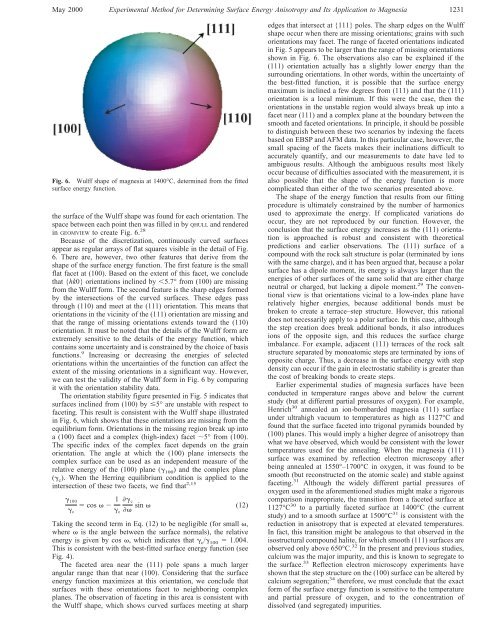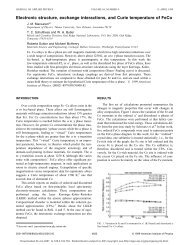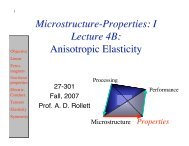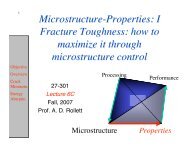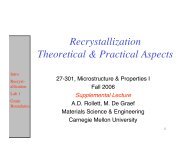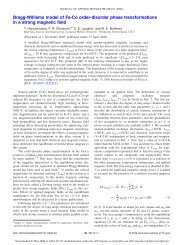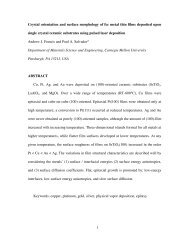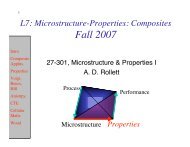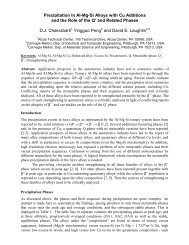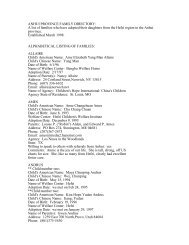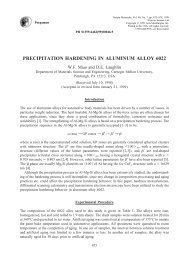Experimental Method for Determining Surface Energy - Materials ...
Experimental Method for Determining Surface Energy - Materials ...
Experimental Method for Determining Surface Energy - Materials ...
Create successful ePaper yourself
Turn your PDF publications into a flip-book with our unique Google optimized e-Paper software.
May 2000 <strong>Experimental</strong> <strong>Method</strong> <strong>for</strong> <strong>Determining</strong> <strong>Surface</strong> <strong>Energy</strong> Anisotropy and Its Application to Magnesia 1231<br />
Fig. 6. Wulff shape of magnesia at 1400°C, determined from the fitted<br />
surface energy function.<br />
the surface of the Wulff shape was found <strong>for</strong> each orientation. The<br />
space between each point then was filled in by QHULL and rendered<br />
in GEOMVIEW to create Fig. 6. 28<br />
Because of the discretization, continuously curved surfaces<br />
appear as regular arrays of flat squares visible in the detail of Fig.<br />
6. There are, however, two other features that derive from the<br />
shape of the surface energy function. The first feature is the small<br />
flat facet at (100). Based on the extent of this facet, we conclude<br />
that {hk0} orientations inclined by 5.7° from (100) are missing<br />
from the Wulff <strong>for</strong>m. The second feature is the sharp edges <strong>for</strong>med<br />
by the intersections of the curved surfaces. These edges pass<br />
through (110) and meet at the (111) orientation. This means that<br />
orientations in the vicinity of the (111) orientation are missing and<br />
that the range of missing orientations extends toward the (110)<br />
orientation. It must be noted that the details of the Wulff <strong>for</strong>m are<br />
extremely sensitive to the details of the energy function, which<br />
contains some uncertainty and is constrained by the choice of basis<br />
functions. 9 Increasing or decreasing the energies of selected<br />
orientations within the uncertainties of the function can affect the<br />
extent of the missing orientations in a significant way. However,<br />
we can test the validity of the Wulff <strong>for</strong>m in Fig. 6 by comparing<br />
it with the orientation stability data.<br />
The orientation stability figure presented in Fig. 5 indicates that<br />
surfaces inclined from (100) by 5° are unstable with respect to<br />
faceting. This result is consistent with the Wulff shape illustrated<br />
in Fig. 6, which shows that these orientations are missing from the<br />
equilibrium <strong>for</strong>m. Orientations in the missing region break up into<br />
a (100) facet and a complex (high-index) facet 5° from (100).<br />
The specific index of the complex facet depends on the grain<br />
orientation. The angle at which the (100) plane intersects the<br />
complex surface can be used as an independent measure of the<br />
relative energy of the (100) plane ( 100) and the complex plane<br />
( c). When the Herring equilibrium condition is applied to the<br />
intersection of these two facets, we find that 2,15<br />
100 cos <br />
c 1 c sin (12)<br />
c <br />
Taking the second term in Eq. (12) to be negligible (<strong>for</strong> small ,<br />
where is the angle between the surface normals), the relative<br />
energy is given by cos , which indicates that c/100 1.004.<br />
This is consistent with the best-fitted surface energy function (see<br />
Fig. 4).<br />
The faceted area near the (111) pole spans a much larger<br />
angular range than that near (100). Considering that the surface<br />
energy function maximizes at this orientation, we conclude that<br />
surfaces with these orientations facet to neighboring complex<br />
planes. The observation of faceting in this area is consistent with<br />
the Wulff shape, which shows curved surfaces meeting at sharp<br />
edges that intersect at {111} poles. The sharp edges on the Wulff<br />
shape occur when there are missing orientations; grains with such<br />
orientations may facet. The range of faceted orientations indicated<br />
in Fig. 5 appears to be larger than the range of missing orientations<br />
shown in Fig. 6. The observations also can be explained if the<br />
(111) orientation actually has a slightly lower energy than the<br />
surrounding orientations. In other words, within the uncertainty of<br />
the best-fitted function, it is possible that the surface energy<br />
maximum is inclined a few degrees from (111) and that the (111)<br />
orientation is a local minimum. If this were the case, then the<br />
orientations in the unstable region would always break up into a<br />
facet near (111) and a complex plane at the boundary between the<br />
smooth and faceted orientations. In principle, it should be possible<br />
to distinguish between these two scenarios by indexing the facets<br />
based on EBSP and AFM data. In this particular case, however, the<br />
small spacing of the facets makes their inclinations difficult to<br />
accurately quantify, and our measurements to date have led to<br />
ambiguous results. Although the ambiguous results most likely<br />
occur because of difficulties associated with the measurement, it is<br />
also possible that the shape of the energy function is more<br />
complicated than either of the two scenarios presented above.<br />
The shape of the energy function that results from our fitting<br />
procedure is ultimately constrained by the number of harmonics<br />
used to approximate the energy. If complicated variations do<br />
occur, they are not reproduced by our function. However, the<br />
conclusion that the surface energy increases as the (111) orientation<br />
is approached is robust and consistent with theoretical<br />
predictions and earlier observations. The (111) surface of a<br />
compound with the rock salt structure is polar (terminated by ions<br />
with the same charge), and it has been argued that, because a polar<br />
surface has a dipole moment, its energy is always larger than the<br />
energies of other surfaces of the same solid that are either charge<br />
neutral or charged, but lacking a dipole moment. 29 The conventional<br />
view is that orientations vicinal to a low-index plane have<br />
relatively higher energies, because additional bonds must be<br />
broken to create a terrace–step structure. However, this rational<br />
does not necessarily apply to a polar surface. In this case, although<br />
the step creation does break additional bonds, it also introduces<br />
ions of the opposite sign, and this reduces the surface charge<br />
imbalance. For example, adjacent (111) terraces of the rock salt<br />
structure separated by monoatomic steps are terminated by ions of<br />
opposite charge. Thus, a decrease in the surface energy with step<br />
density can occur if the gain in electrostatic stability is greater than<br />
the cost of breaking bonds to create steps.<br />
Earlier experimental studies of magnesia surfaces have been<br />
conducted in temperature ranges above and below the current<br />
study (but at different partial pressures of oxygen). For example,<br />
Henrich 30 annealed an ion-bombarded magnesia (111) surface<br />
under ultrahigh vacuum to temperatures as high as 1127°C and<br />
found that the surface faceted into trigonal pyramids bounded by<br />
(100) planes. This would imply a higher degree of anisotropy than<br />
what we have observed, which would be consistent with the lower<br />
temperatures used <strong>for</strong> the annealing. When the magnesia (111)<br />
surface was examined by reflection electron microscopy after<br />
being annealed at 1550°–1700°C in oxygen, it was found to be<br />
smooth (but reconstructed on the atomic scale) and stable against<br />
faceting. 31 Although the widely different partial pressures of<br />
oxygen used in the a<strong>for</strong>ementioned studies might make a rigorous<br />
comparison inappropriate, the transition from a faceted surface at<br />
1127°C 30 to a partially faceted surface at 1400°C (the current<br />
study) and to a smooth surface at 1500°C 31 is consistent with the<br />
reduction in anisotropy that is expected at elevated temperatures.<br />
In fact, this transition might be analogous to that observed in the<br />
isostructural compound halite, <strong>for</strong> which smooth (111) surfaces are<br />
observed only above 650°C. 32 In the present and previous studies,<br />
calcium was the major impurity, and this is known to segregate to<br />
the surface. 33 Reflection electron microscopy experiments have<br />
shown that the step structure on the (100) surface can be altered by<br />
calcium segregation; 34 there<strong>for</strong>e, we must conclude that the exact<br />
<strong>for</strong>m of the surface energy function is sensitive to the temperature<br />
and partial pressure of oxygen, and to the concentration of<br />
dissolved (and segregated) impurities.


